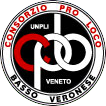GEOGRAPHY
Roverchiara is 34 km away from Verona and with its surface of 20 km² it is located at an altitude of 20 m above sea level. The village is on the right bank of the river Adige, which marks the eastern border of Roverchiara’s territory. River Bussè, another important watercourse, flows through the town. Roverchiara is surrounded by several localities. It borders with the comuni of Isola Rizza, Albaredo d’’Adige, Bonavigo, Aangiari, San Pietro di Morubio and Ronco all’Adige
ETYMOLOGY
The town’s name in acient time was “Fonzane”, from the name of a local family. There are two theories about the origins of the name of Roverchiara. The first attributes the name to the Latin word “rubiclus”, diminutive of “rubus”, “rovo” in Italian, meaning “bramble” or more generally “priclky shrub”. The word would have changed with time in “Rublicus, Rovèclo, Rovechio, Rovecio, Roecio, Roeciara, Roverciara” and finally Roverchiara. The second theory claims that the name originated in “Ripaclara”, a name that recalls the lighthouse of the harbour on river Adige that once lit up the river shore.
HISTORY
The discovery of some coins suggests that during the Roman era the area was already inhabited. In the official documents Roverchiara appears since the 700s. The first written information about the town dates back to 813, in a document that describes a Christian community called Schola Cantorum, to which bishop Rotaldo of Verona granted some income and property. The religious communty counted a large number of vicars at its service: 36 priests and other prelates with minor roles. The religious and economic relationship between the bishop and this community ended in 1206 when the comune of Verona took over the episcopal property and imprisoning bishop Adelardo II in the town of Monteforte.
In 1234 Ezzelino da Romano, in order to cross the river Adige with its troops and conquer the comune of Albaredo, built a wooden bridge remarkably engineered. Between the late 1200s and the 1300s these lands were subjected to the domination of the Scaligeri, later they passed under the Visconti and finally for several centuries were dominated by Venice that developed river navigation and built a port in Roverchiara. In 1866, after the Third Italian War of Independence, the town was finally freed from the Austrian regime and joined the Kingdom of Italy, but a long time had to pass before Roverchiara could become relevant again in the local economy.
ART
Inside the church of San Zeno there is a “Cristo crocifisso con i Santi Sebastiano e Rocco”, painted in the late 1500 by Paolo Farinati, and a “Madonna con i Santi Sebastiano e Rocco”, opera di Francesco Montemezzano. Also worth seeing is the parish of Roverchiaretta, the shrine of “Madonna delle Grazie” of the 1600s with its valuable decoration. Around Roverchiara there are Villas and Manors built between the 1500s and the 1700s such as: villa Guarienti-Brenzoni (1530), villa Pindemonti-Fiumi (1745), inside it there are some interesting wooden ceilings and the museum dedicated to the poet Lionello Fiumi, currently the villa hosts the town hall. There are also: Villa Guerra built in the eighteenth century, Villa and Corte Sagramoso Quartasola that now is an agritourism, palace Brenzon in Bogon, Corte Sabbionara in Cappafredda, Corte domenicale Marogna in Casalino and Corte Torre Gazzola.
ECONOMY
Agriculture is the leading branch of Roverchiara’s economy. There are several farms that make use of modern technological equipment and techniques. Corn, wheat, beets, tobacco, vegetables, apples, pears and kiwis are the most farmed products. There are in addtion some important cattle, pig and bird farms. Due to the “Transpolesana” road, the town experienced a development of trade, industry and craftsmanship.
